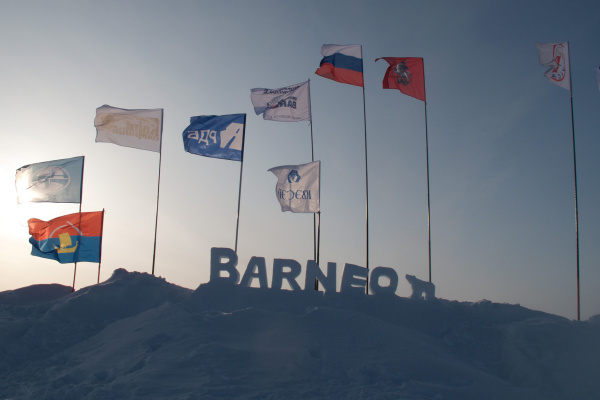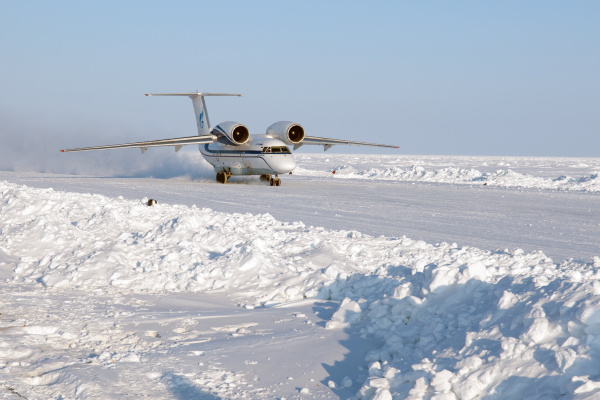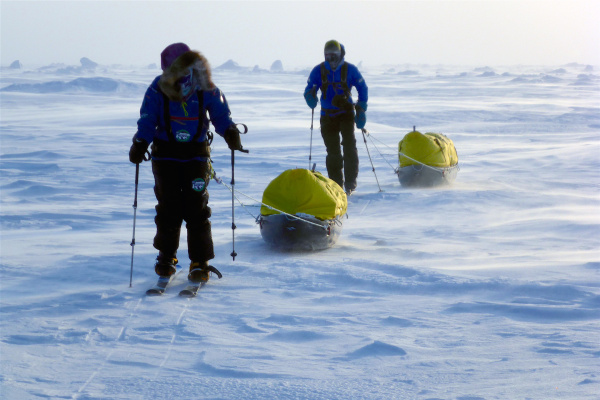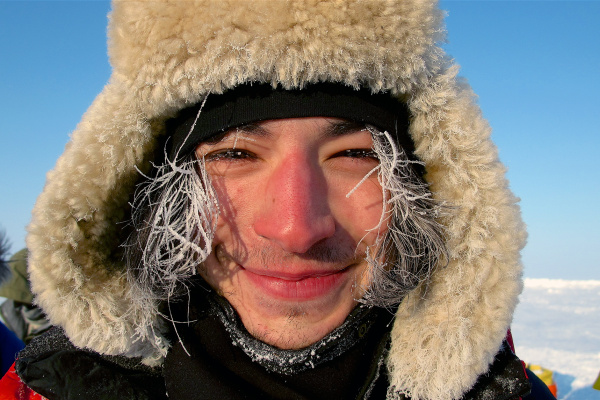Ski the last degree to the top of the world
Pressure ridges, open leads, sastrugi and ice rubble are natural features of the Arctic Ocean and we may experience them all as we head north to the top of the world on your North Pole Last Degree ski expedition.
- Gateway Khatanga, Russia
- Distance 112km
- Days on Ice 10
- Daily Distance 14km
- Temp. Range -20 to -30°C
- Sled Weight 45kg
- Challenge 5 What's this?
- Conditions Cold climate, ice pressure, open water, 24hr daylight
- Challenges Skiing against drift, cold and moisture management
Trip Itinerary
EXPEDITION - APRIL 1 to 14, 2025
Arrive in Krasnoyarsk with your expedition clothing and equipment (see Getting There).
Transfer to Krasnoyarsk airport for 3.5 hour charter flight to Khatanga. Arrive Khatanga, check in to hotel.
Expedition preparation
Five hour flight to Barneo Ice Camp. Final preparations. Helicopter flight to start point and begin ski expedition.
Averaging around 14km per day (not including ice drift) we ski northward until we reach the North Pole, camping there if time permits.
Helicopter pick up from Pole and return to Barneo. Flight back to Khatanga and Krasnoyarsk. End of services.
Inclusions
- Airport transfers for flights north
- Khatanga local ski training
- All plane and helicopter flights associated with the expedition program
- Food and stove fuel during the expedition
- Guide/s
- Use of specialist equipment including tents, sleeping bags, sleds, skis. This equipment is returned after the expedition (see equipment list)
- Safety/navigation/communications equipment
- 45kg weight allowance (inc. food and group equipment)
- 20% discount on select Icetrek Equipment
Exclusions
- Krasnoyarsk airport transfers other than flight to Khatanga
- Hotel accommodation in Khatanga
- Accommodation and meals at Barneo other than indicated
- Excess baggage (€50/kg)
- Additional costs (accommodation, meals etc.) due to changes beyond our control ie. weather delays
- Evacuation, cancellation, hospitalization and repatriation costs and/or insurance
After flying 5 hours by Antonov-74 aircraft from Khatanga to Barneo Ice Camp we collect stove fuel before flying by Mi-8 helicopter to 89° north, 112km from the North Pole. Temperatures range between -20° to –35°C but comfortably so in state-of-the-art polar clothing. Towing our own sleds the challenge is finding a suitable route through the pressure ridges and around the leads of open water. This is true Arctic Ocean expeditioning, alone against the elements, challenging the drift, overcoming the constant obstacles.
Teamwork is essential as there is much to do - navigating, camp selection, tent pitching, communications. Inside the tent the atmosphere is warm and comfortable and 24-hour daylight allows for a wide range of extra activities such as photography, reading, writing and exploring.
Skiing 10–15 kilometres per day there is no shortage of time to explore the real Arctic Ocean. Everything before us is as it was centuries ago, when early explorers first ventured into this truly remote region. The feeling is one of isolation and exclusivity, as if we are the first to discover the North Pole. After 7-8 days we reach the North Pole and celebrate our arrival at the top of the world. To top it off we may spend the night here before being collected by helicopter the next day.
We return on the 40-minute flight to Barneo and if time permits we may spend the night there. Return flight Khatanga and onward to Krasnoyarsk.
North Pole Last Degree is an outstanding polar expedition, giving every participant a deep insight into Arctic Ocean adventuring.
Morning
We wake around 6am and a call goes out to all of the tents. With the temperature inside the tent almost the same as outside, it's a little tough emerging from a warm sleeping bag to light the stove but it's a necessity for the nominated cook for the day/night to warm the tent and get breakfast and drinks ready. The other tent partner has the luxury of snoozing a little longer. But eventually everyone is sitting up in their comfortable camp seats, enjoying the warmth and sipping on a hot tea or coffee.
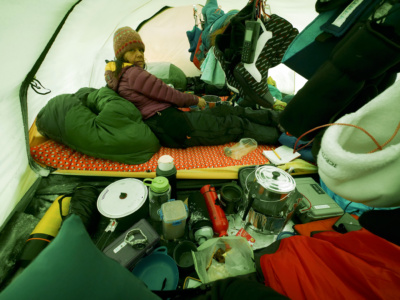
A hearty breakfast of high-energy porridge with milk powder, desiccated coconut, crushed pecans and protein powder, together with butter for those needing the energy, gets us fired up and ready for the day of hauling. We call it our breakfast bomb. But we have it as late as possible so that all of its energy is available for the morning sessions. Reheating thermoses and melting snow for water is also a morning task, one that consumes a fair bit of time.
Another morning task is to check the GPS for any overnight drift. Will we be lucky and drift north or will luck, like the drift, be against us? Drift could also be sideways or non-existent. Drift always plays a big part in an Arctic Ocean expedition. We try and start the trip from a position that maximises positive drift but it can never be guaranteed.
Slowly we start to pack all of our belongings, timing everything with the completion of snow melting so that once all tasks are done we can exit the tent and start packing our sleds. Hopefully we have choreographed this with the other tents so that no-one is waiting in the cold.
First session
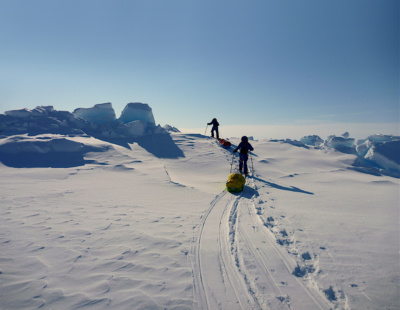
Around 9am, tents collapsed, decamped and sleds packed, we clip into our harnesses, check our bearing and begin the first session of hauling. A few days into the trip and we will have found a daily routine and rhythm that suits the team, something like 4 sessions of 2 hours each with 20-minutes break in between, a little longer for lunch. There's ample time to take a little drink during the sessions because we are often stopped by pressure ridges or open water giving the team a mini break while the guide scouts ahead. Sled hauling is not very difficult when conditions are perfect, pulks often glide easily across the ice. It gets tougher when we are confronted by pressure ridges where we need to pull the sleds up and over hard blocks of ice. Sometimes it's easier to take skis off and sometimes we need two or three people per sled to get them over bigger obstacles.
More exciting are crossings of thin ice or open water. Your guide is highly experienced in all situations and thin ice and water crossings are a natural part of North Pole expeditioning. Your guide first tests thin ice with prods from a ski pole and scans the scene for telltale features that give away the integrity of the ice. If it's thick enough you'll ski across. If not you'll follow the edge of the lead and look for a narrowing of the crack. Open water crossing techniques include spanning narrow cracks with a sled, perhaps two, and skiing or clambering across, rafting sleds and paddling across or swimming in a dry suit and setting up a raft of two sleds connected side-by-side to ferry everyone across. We carry throw ropes, ferry reels and a dry suit for every eventuality.
We are also on the lookout for polar bears. It's very rare to see them this far north but we prepare for the eventuality by scanning the horizon regularly, carrying flare guns and a powerful rifle as a last resort.
Break
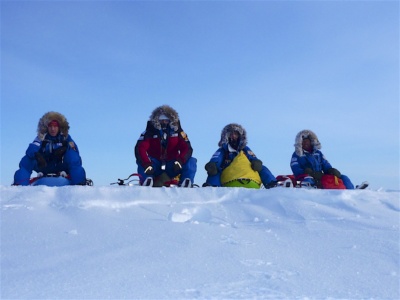
If there's even the slightest wind we'll look for a ridge to shelter behind when we take a break. If it's cold we'll put on our down jackets, over the top of the harness. A day bag containing food and drink, and anything else you might need during the day, is kept in the nose of the sled for easy access and it's not long before we're sitting on our sleds downing a selection of delicious snacks including crackers, energy bars, dried fruit and nuts, lollies and chocolate which help to keep us going during the next session. The breaks also serve as toilet stops.
Second session
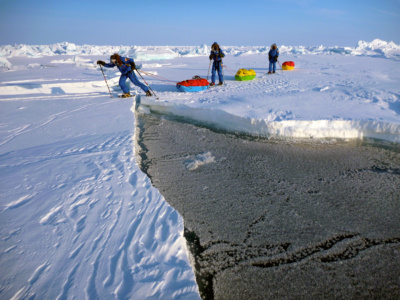
After 15-20 minutes we are off again, heading north across the vast frozen ocean. If conditions are predictable there's opportunity for you to be out front, breaking trail, route finding, navigating, decision making. Don't worry, your guide is always nearby and ready to give advice or take over if it starts getting a bit hairy.
Your skis, skins, bindings, ski poles and boots are all designed for this kind of expedition. It takes a little while to become accustomed to the bulkier ski equipment, but eventually it feels very natural and it is certainly very warm. We design and manufacture our own Flexi Ski Bindings which are purpose built for North Pole expeditions. Your clothing too is designed to keep you warm and comfortable in the coldest of temperatures.
The weather can be anything from blue skies, no wind and -35c to warm, sticky blizzards where the temperature can rise to -5c. Fog, snow, clouds, almost anything is possible up here. Sometimes we also see evidence of open water in the skies. If it's cloudy open water is often reflected on clouds as a dark patch and if it's clear we can sometimes see 'water sky', palls of condensed fog above pools of water.
Lunch
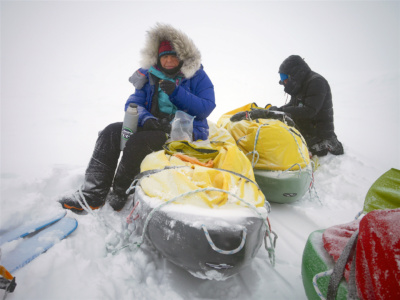
We stop for lunch out of the wind and put on warm jackets and take our skis off. First task is to add hot water to our noodles so that they are ready to eat in around 3 minutes. A chunk of cheese in with the noodles provides a mouth-watering stringy melt that is both soft and delicious. The lunch break is a great opportunity to chat, or just enjoy the surroundings, whatever you like.
Afternoon sessions
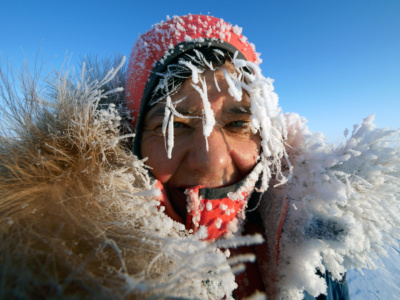
We also carry goggles and a change of hat in our day bag. Blue skies and calm can switch to blizzard, or anything in between, so we need to have quick access to variations in our head and hand wear so that we stay warm and dry. The art of polar travel includes reducing perspiration to a minimum and we do this through venting - allowing the moisture to escape. Base layers wick moisture away from the skin, fleece layers continue the transfer while keeping us warm and breathable shell layers allow the moisture to escape to the outside. Zippers strategically located on our shell-wear assist in the venting process and a skilled traveler knows the importance of actively managing the moisture within. So no matter the weather, we remain in fine control of our body temperature and dampness through a balance of food, fluids and clothing.
As the day progresses we feel the onset of fatigue. And no wonder - we have travelled up to 8 hours, crossed many pressure ridges, negotiated any open water, meandered over and around obstacles, skis on, skis off, dragging our own sleds, sometimes assisting others, covering a distance further than the GPS reveals. It's time to camp.
Evening
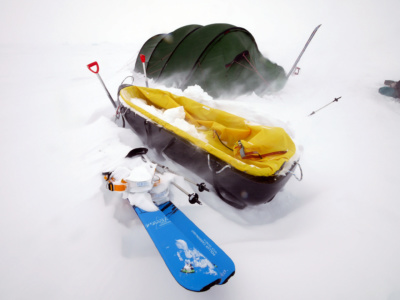
After selecting a camp site that takes into consideration the number of tents, weaknesses (cracks, pressure ridges, ice thickness), shelter from wind and proximity to snow for melting, we pitch tents, using either snow stakes or ice screws for anchoring, depending on the surface. Snow is shovelled on the tent valances for added security and sealing from blizzards and a bag of snow blocks for melting is collected. After tossing anything we need for the night inside we climb in and prepare a cosy and ordered interior. Soon the stove is purring, the tent is warming, snow is melting and damp things hang on the drying line. Soup, dinner and some squares of chocolate for desert await and banter fills the tent. For those staying in touch, satellite phones and modems are warmed and the world hears of our progress through phone calls, emails, texts and blogs. We can send images too, bringing our wonderful expedition to life for the folks back home. A daily call to Barneo keeps their expedition manager up to date and we get a weather report, which we can also download on our modem.
On average, our day is divided into three eight-hour periods. The most important one is sleep - eight hours is available if you want it. Eight hours of hauling also becomes a standard as it helps us to cover ground and pace our day. The third eight hours is anything not sleeping and not hauling - rests, lunch, chores and camp life. If we need to cover more distance during the day we can easily compress our down time to give more hauling time, but sleep is sacrosanct, critical for our health and happiness. And after all is done we turn the stove off, slide into our sleeping bags, ruffle our down jacket pillow and sleep the sleep of explorers, to awake to a new dawn and live an Arctic day once again.

INTERNATIONAL TRAVEL
Russia is open to international travellers. You are required to arrive in Krasnoyarsk on the day before your scheduled program start date and arrange accommodation. Thereafter we arrange everyghing.
By Air
Flights to Moscow or St. Petersburg are available from:
- Serbia, Turkey, Armenia, Azerbaijan, Georgia
- UAE, Qatar, Bahrain, Oman, Kuwait, Iran, Iraq, Syria
- Kazakhstan, Kyrgyzstan, Uzbekistan, Tajikistan, Afghanistan
- China, India, Vietnam, Thailand, Sri-Lanka, Maldives, Mongolia, Myanmar
- Algeria, Egypt, Morocco, Tunis, Seychelles, Ethiopia
- Venezuela, Cuba
Domestic flights to Krasnoyarsk are readily available. These flights are not included in the price.
By Land
You can fly to Finland or Estonia and take a regular bus or van to St. Petersburg.
DOMESTIC TRAVEL
There are several flights from Moscow and St. Petersburg to Krasnoyarsk every day.
VISAS
For most travellers a visa is required for Russia.
We will provide you with a formal letter of invitation which must be submitted together with your visa application to the Russian consulate in your country. As you will fly from Russia to Barneo Ice Camp and then return to Russia, considered an international flight, you should apply for a double-entry Russian visa.
KRASNOYARSK
Krasnoyarsk is the capital of Siberia with a population over 1 million. You should arrive in Krasnoyarsk at least 1 day prior to the planned date of departure on your Barneo program. You will be met at the airport and transferred to your hotel.

Accommodation
There is an abundance of hotels in the city that can meet every preference. Use your preferred accommodation aggregator to find suitable accommodation. Hotel accommodation in Krasnoyarsk is not included in the price.
Hospitality
Should you wish to arrive early you can discover a range of Krasnoyarsk hospitality including restaurants and cafés of all tastes, city tours, museums, the Yenisey river and a visit to Pillars National Park can be arranged upon prior request.
HEADING NORTH
On the date of departure for your program you will be transferred from your hotel to the airport. Here you will board the Antonov-74 aircraft for a 3.5 hour charter flight north to Khatanga village. From Khatanga your journey to Barneo and the North Pole starts in earnest.
KHATANGA
Khatanga is a village of 3500 inhabitants located just below 72º north. Here you will be accommodated in the newly refurbished hotel where we make final preparations for your North Pole journey.
Usual food staples are available as well as alcohol, medicines, dry goods, toiletries, however at a higher price than available in big cities.

What is North Pole Last Degree?
North Pole Last Degree is a ski expedition on the frozen Arctic Ocean starting at 89º north and ending at 90º north, the Geographical North Pole. The precise distance of one degree of latitude is 60 international nautical miles, 111.1 kilometres and 69.05 statute miles.
Can I leave bags in Khatanga?
Yes. Luggage will be stored securely.
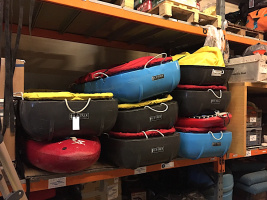
*
What should I wear on the flight from Khatanga to Barneo Ice Camp?
You will be briefed in Khatanga on exactly what to wear and bring on the flight to Barneo Ice Camp. Usual airline restrictions apply.
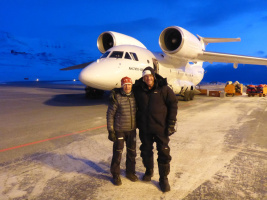
*
How long is the flight to Barneo?
The flight from Khatanga to Barneo takes around 5 hours.
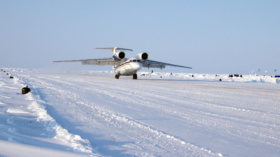
*
Should I take money and my passport to Barneo?
There is nothing available for purchase at Barneo but you need to bring your passport.
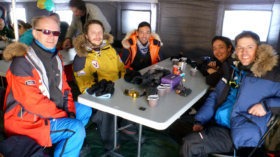
*
What will be the temperature on arrival at Barneo?
The temperature at Barneo in April will be anywhere from -15 to -40C, 5 to -40F
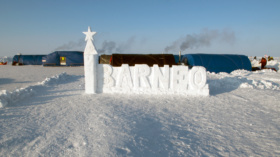
*
How heavy will my sled be?
For a North Pole last degree expedition your sled will be 35 to 45 kg, 77 to 100 lb.
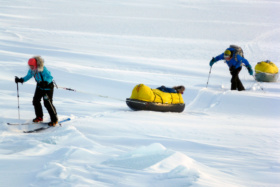
*
What if I am not a skier?
Many of our North Pole Last Degree customers have never been on skis before. We will train you in Khatanga and coach you while you are on the ice. When we are challenged by pressure ridges you can remove your skis and climb over.
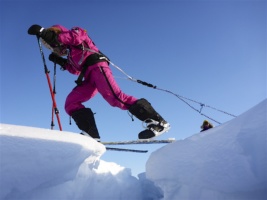
*
How long is the helicopter flight to the start?
This depends on the location of Barneo which is a drift station. On average the flight from Barneo to 89° is 20 minutes.
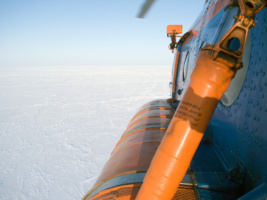
*
What is the thickness of the Arctic Ocean ice?
On average the Barneo runway, situated on the frozen Arctic Ocean, is placed on ice 1.7 to 1.8 m thick. We ski across ice anything between 5 cm and 2 m thick.

*
Will there be any open water leads?
We cannot predict whether there will be any open water leads until the season begins. On average we are confronted by cracks in the ice every couple of days. But some seasons we see no open water and some seasons we see open water every day. We use a number of different techniques to cross open water depending on the width of the lead.
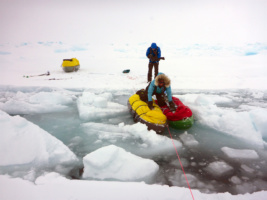
*
Will there be any pressure ridges?
Yes. Ice pressure is one of the most prevalent features of the Arctic Ocean. Often we can ski around them, sometimes we can ski over them and now and then we need to remove skis and climb over them.
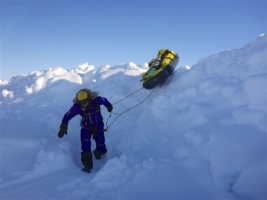
*
What type of sleds do we use?
We use Icetrek Nilas sleds made from slippery HDPE plastic. These are purpose designed and built by us and give optimal performance on flat ice and snow, through pressure ridges and as rafts across open water.
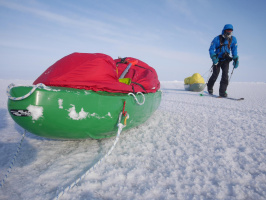
*
What type of tents do we use?
We use Hilleberg Keron 4-person tents for two people. There is plenty of room to get comfortable but small enough to warm up quickly once the stove is operating. You are responsible for setting up, managing and taking down your tent.
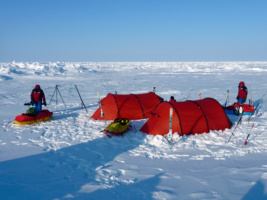
*
What type of sleeping bags and mattresses do we use?
We use Red Fox synthetic sleeping bags rated to -40 and a Thermarest/Ridgerest mattress combination with a 6+ R-Value. We also use Thermarest Trekker Lounge chairs to sit up and rest comfortably in the tents. We use synthetic fill because it tolerates moisture very well, retaining loft, and warmth, if it gets damp.
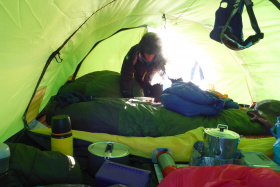
*
What will we eat on the expedition?
You can find our menu here
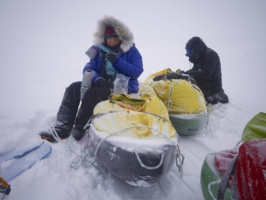
*
Who cooks the meals and melts the snow for water?
You do! This is a normal part of expedition life. We train you in Khatanga.

*
What if there is an emergency and how will we communicate with the outside world?
We carry an Iridium handheld phone and an Iridium modem, we can use both to call Barneo and the outside world and post an updated and images daily to our Iceblog. We also carry a tracking beacon with emergency function and a Personal Locator Beacon which can be activated in an emergency. Signals from both are received by emergency services and relayed to Barneo. Two helicopters and a doctor are based at Barneo
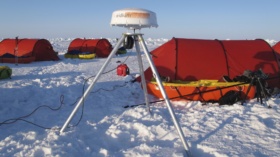
*
How long do we ski every day on a North Pole expedition?
We start relatively gently, skiing for around six hours on the first day. We cover this by skiing one hour, then have a short stand-up break, then another hour with a sit down break. We do the same again and have lunch and then another 2 hourly sessions before camping. When everybody feels ready we extend to 7 and perhaps eight hours per day.
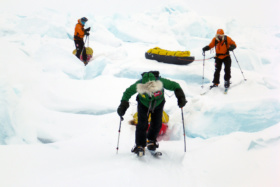
*
How do we know when we are at the North Pole?
We use a GPS to find the North Pole, exactly 90°.
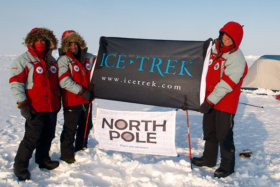
*
Feel free to submit your own questions.
